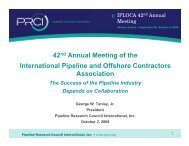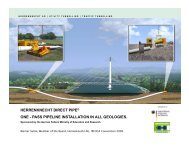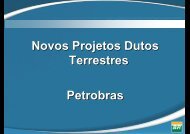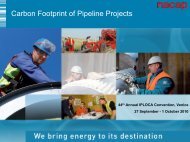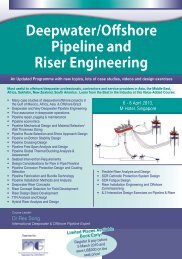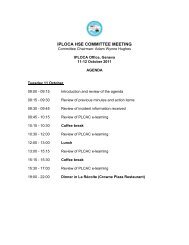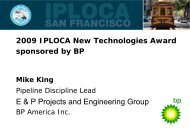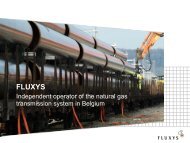EPRG-PRCI-APIA 17th JOINT TECHNICAL MEETING ON ... - Iploca
EPRG-PRCI-APIA 17th JOINT TECHNICAL MEETING ON ... - Iploca
EPRG-PRCI-APIA 17th JOINT TECHNICAL MEETING ON ... - Iploca
Create successful ePaper yourself
Turn your PDF publications into a flip-book with our unique Google optimized e-Paper software.
<strong>EPRG</strong> Project 138: Comparison of European (EN) and International (ISO) linepipe<br />
standards<br />
When the European Standard EN 10208-2 was issued in 1996, the International Standards<br />
Organisation also issued an equivalent standard, ISO 3183:1996. The ISO standard has<br />
since been revised and reissued in 2007, and the EN standard is now in the process of being<br />
revised. <strong>EPRG</strong> has undertaken a thorough comparison of the requirements of the two<br />
standards to identify areas for harmonisation, to identify differences and to form the basis of<br />
an opinion as to whether the ISO standard should be adopted in Europe, particularly for gas<br />
transmission pipelines.<br />
<strong>EPRG</strong> Project 136: Methods for evaluating the fracture resistance of high grade<br />
steel pipelines<br />
Recent studies by <strong>EPRG</strong> have focused on thoroughly reviewing the underlying principles of<br />
fracture propagation and arrest prediction methods, and the limitations encountered when<br />
they are used to characterise high grade steel pipes and predict their fracture arrest<br />
behaviour. The results of these reviews show that, while the applicability of the Battelle Two-<br />
Curve Method is very questionable for the highest steel grades, no unambiguous alternative<br />
fracture parameters are available. To move from this ‘stalemate’ will require further attention<br />
to the relationship between the dynamic behaviour of laboratory specimens and full-scale<br />
pipes, in order to understand the effects of constraint (ligament length, wall thickness and<br />
geometrical bending etc) on crack propagation and arrest, and the role of material ductility in<br />
the failure process.<br />
See also in the JTM Programme booklet:<br />
Paper 1: Nord Stream Project – a challenge for a pipe manufacturer<br />
Paper 2: Investigations on microstructure, mechanical properties and weldability of a<br />
low-carbon steel for high strength helical linepipe<br />
Paper 3: Overview of materials compatibility issues with fuel-grade ethanol<br />
Paper 4: Does extensive HAZ testing lead to enhanced pipeline safety<br />
Paper 5: Assessment of work-hardening behaviour of HFI-welded pipes for strainbased<br />
design<br />
Paper 16: An alternative to the pre-service hydrotest



